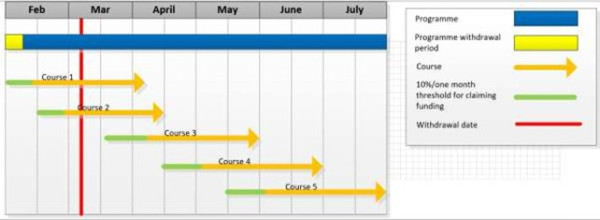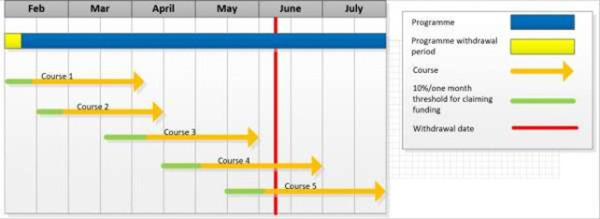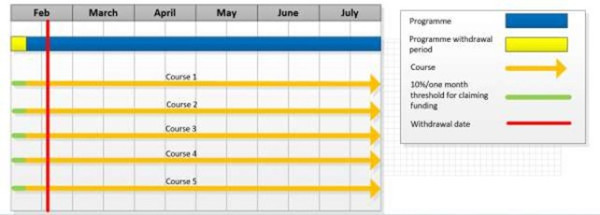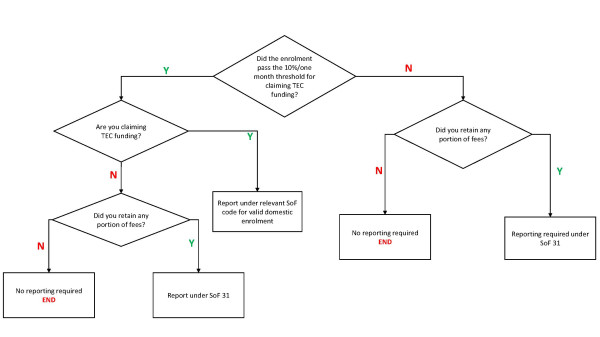Enrolment – DQ7+
Enrolment – DQ7+
This page has information about Delivery at Levels 7 (degree) and above on the New Zealand Qualifications and Credentials Framework (DQ7+) Fund learner admission and enrolment, verification of learner identity and eligibility, payment and refund of fees, confirmed learner enrolments, and learner withdrawals.
This page has information about Delivery at Levels 7 (degree) and above on the New Zealand Qualifications and Credentials Framework (DQ7+) Fund learner admission and enrolment, verification of learner identity and eligibility, payment and refund of fees, confirmed learner enrolments, and learner withdrawals.
Enrolment restrictions
You may restrict the number of eligible learners who can enrol in a programme in accordance with section 255(4) of the Education and Training Act 2020. We recommend that you determine and publish the maximum number of learners who can enrol in a particular programme leading to the award of a qualification or course each year, and your criteria and processes for selecting learners into the restricted entry programmes or courses.
You may:
- set minimum entry standards for qualifications or courses
- require a learner to achieve satisfactory academic progress
- require a learner to complete another qualification first, and/or
- set admission limits (for example, capped numbers of high cost DQ7+ provision such as dentistry and aviation) – for more information see Programme eligibility – DQ7+.
You must not, however, restrict enrolment in a programme for which DQ7+ funding is provided based on private advantage (for example, restricting enrolment to the tertiary education organisation’s (TEO’s) employees only). For more information see the funding conditions for the relevant year.
Enrolment form
An enrolment form should collect all of the information that a TEO is required to report in the Single Data Return (SDR).
To identify all the information that you are required to collect, see the SDR Manual.
You may also use the Ministry of Education’s generic enrolment form.
We recommend that you publish your enrolment form.
For information on enrolment records and SDR reporting information see the funding conditions.
Enrolment application
To enrol in a programme leading to award of a qualification, the learner needs to apply to the TEO by:
- completing and submitting the TEO’s enrolment form, and
- providing evidence to enable the TEO to:
- verify the learner’s identity, and determine the learner’s eligibility (see DQ7+ funding conditions for the relevant year)
Enrolment process
We recommend that a TEO’s admission and enrolment process for DQ7+ includes the steps below:
DQ7+ enrolment process |
||
|
Step |
Responsibility |
Action |
|
1 |
TEO |
Provides information on qualification programmes of study (including courses), the admission and enrolment process, and the withdrawal and fees refund process (including any impacts on learner eligibility for fees-free tertiary education in the future) |
|
2 |
Learner |
Applies to the TEO for admission and enrolment (separately or together) |
|
3 |
TEO |
Verifies the learner’s identity |
|
4 |
TEO |
Confirms the learner’s eligibility to study (and eligibility for provision funded through DQ7+) |
|
5 |
TEO |
Recognises prior learning |
|
6 |
TEO |
Makes a formal offer to enrol the learner on a course or programme of study, excluding recognised prior learning |
|
7 |
Learner |
Formally accepts the offer |
|
8 |
TEO |
Records the enrolment |
|
9 |
TEO |
Invoices the learner for any tuition fees and charges, including any student services fees (SSFs) adjusted post-recognised prior learning |
|
10 |
Learner |
Pays any tuition fees and charges, or arranges for them to be paid |
|
11 |
TEO |
Records payment of any tuition fees and charges |
|
12 |
TEO |
Provides the learner with information about all planned learning activities in their programme |
|
13 |
TEO |
Provides refunds for learners who withdraw from courses within the defined withdrawal period for fees refund, and records these refunds |
|
14 |
TEO |
Records the learner as a confirmed learner enrolment once the fees refund period has passed |
|
15 |
TEO |
Records the learner as a valid domestic enrolment once the 10% or one month (whichever is earlier) period for eligibility for TEC funding has passed |
Note: We expect the TEO to inform each learner during the enrolment process about all planned learning activities leading to the award of the qualification the learner has enrolled in. “Planned learning activities” includes self-directed learning activities the TEO expects the learner to engage with/participate in. It does not include self-directed activities the learner initiates.
Also note that there are additional enrolment requirements under the New Zealand Qualifications Authority (NZQA) Rules and Tertiary and International Learners Code of Practice.
For requirements when enrolling learners in DQ7+ funded provision, see DQ7+ funding conditions for the relevant year.
Admission
We expect you to publish admission information before the start of each programme. This information should include:
- admission requirements
- tuition fees and other course costs
- criteria and process for selecting learners for entry into restricted entry courses (if relevant)
- criteria and process for assessing and recognising a learner’s prior learning
- criteria and process for cross-crediting courses across multiple qualifications
- documents that a learner must submit (for example, a learner’s academic transcript or record from another TEO)
- the enrolment process
- minimum attendance and code of conduct requirements
- withdrawal requirements and process, including refunds
- learner support services available, and
- student services fees (SSFs) information in accordance with the relevant funding conditions on SSFs.
For requirements of both tertiary education institutions (TEIs) and private training establishments (PTEs) to provide information about fees, see the funding conditions for the relevant year.
Also note that there are additional requirements under the NZQA Rules and Tertiary and International Learners Code of Practice.
Enrolment changes
If a learner’s enrolment changes for any reason, you must update your records to reflect the changes. We recommend you send updated enrolment information to the learner.
Confirmed learner enrolment
All DQ7+ funded TEOs must report all confirmed learner enrolments with a programme start date on or after 1 January 2023 in the SDR. For the definition of a confirmed learner enrolment, see the funding conditions for the relevant year.
Confirmed learner enrolments apply to programme, course and micro-credential enrolments where fees apply, including student service fees (SSFs). It ensures that we gain a wider understanding of TEO enrolments by including enrolments where the TEO receives fees from a learner and does not refund the fees after a withdrawal.
Withdrawals
A “withdrawal” is when a learner ceases to participate in a course, programme or micro-credential (regardless of whether they have been refunded any fees), either:
- by providing notice to the TEO that they wish to withdraw from participation, study and/or enrolment, or
- as a result of non-attendance or non-participation for any reason.
Disengaged learners who have not formally withdrawn
A learner may have disengaged from the programme or micro-credential but not have formally withdrawn. For example, they may not have attended a face-to-face course or not logged in for online learning.
Determine at the earliest opportunity if a disengaged learner is withdrawing from a course. If the enrolment continues to be reported and is unsuccessful, it will be counted as a course non-completion for the calculation of Educational Performance Indicators (EPIs).
Setting a withdrawal date for a withdrawn learner
TEOs need to apply a “withdrawal date” to any enrolment in the Single Data Return (SDR). For the requirements for withdrawal dates for TEIs and PTEs, including reporting withdrawals to StudyLink and other parties, see the funding conditions.
A TEO will not be able to receive funding for an enrolment with a withdrawal date that occurs before 10% or one month of the course has passed (rounded up to the nearest whole day), whichever is earlier.
Learner-centred provision
Learners wanting to defer their start date
You may agree to defer a learner’s enrolment start date, but you should have a policy for the circumstances under which a learner may defer their start date.
Note: No DQ7+ funding can be claimed unless the learner has started their study and the 10% or one month date for accessing funding has passed. For more details see DQ7+ funding conditions for the relevant year.
Learners wanting to accelerate their study (undertake additional learning)
You should not enrol a learner in an additional course or qualification unless the learner elects to exceed the annual equivalent full-time learner (EFTS) value of the qualification to accelerate their programme of study or training. For example, a learner may choose to complete a three-year qualification in two-and-a-half years by undertaking a higher than usual course load each year.
In that instance we expect the additional learning hours to be matched by an appropriate number of additional teaching hours.
Example: a qualification that is 34 weeks each year in length is generally 1.0 EFTS in value each year, which equates to 0.03 EFTS each week.
0.03 EFTS per week x 34 weeks = 1.0 EFTS.
If a learner studies for 52 weeks in a year, the maximum amount of EFTS that we will fund for the learner is 1.56 EFTS.
0.03 EFTS per week x 52 weeks = 1.56 EFTS.
You must ensure that such a learner understands the workload that will be required to achieve their course and qualification completions.
Inducement
An enrolment is not a valid domestic enrolment if the learner has been induced to enrol. For details see the funding conditions for the relevant year.
We recommend that you contact us to discuss this before offering items or activities to learners for enrolling with you.
Learner fees refund period
TEOs need to apply a fees refund period. If a learner withdraws from a course or programme within this period, they must receive a refund of fees (or waiver of fee payment) and course costs (minus any administration fees). The refund period requirements are different for private training establishments (PTEs) and tertiary education institutions (TEIs).
For more information on learner fees refunds, see the funding conditions for the relevant year.
Also see:
- Enrolment changes information in Enrolment
- Confirmed learner enrolments.
Course withdrawal, programme withdrawal and fees refunds
Course withdrawal, programme withdrawal and fees refund practice can determine whether an enrolment must be reported as a confirmed learner enrolment under Source of Funding code 31 (SoF 31). Importantly, these practices can differ for private training establishments (PTEs) and tertiary education institutions (TEIs).
The course enrolment must be reported under SoF 31, regardless of whether:
- a course enrolment passes the 10%/one month threshold for claiming TEC funding, or
- the TEO does not claim funding for the course enrolment, or
- the TEO retains some or all fees for the course enrolment.
For example, in Diagram 1 below this would mean that courses 1 and 2 would be reported under SoF 31 if fees are retained but no TEC funding is claimed.
Withdrawing by programme and retaining fees
For some TEOs, mainly PTEs, when a learner withdraws from study the TEO may withdraw them from the whole programme (or qualification) and retain all the fees for that programme. This is done even though the start date may not have been reached for all course enrolments making up the programme.
TEOs that withdraw learners by programme and retain fees for courses that the TEO does not claim TEC funding for must report these course confirmed learner enrolments under SoF 31.
Withdrawing by course and retaining fees
For other TEOs, when a learner withdraws from study the TEO withdraws the learner from courses within the programme that the learner did not start or participate in for 10% or one month (whichever is earlier). The TEO retains fees only for the courses where the enrolment became a valid course enrolment reported under SoF 01 or SoF 32. TEOs that withdraw learners by course and refund their fees in full do not have to report those enrolments as, at the point of fees refund or waiver, they cease to be confirmed learner enrolments.
Examples
Example 1: The tuition fees required to be refunded to the learner will differ depending on whether the TEO withdraws learners by course or by programme (see Diagram 1)
Diagram 1

- If the TEO withdraws learners by course, the learner will receive a refund of the tuition fees for courses 3, 4 and 5. This is because the fees refund period for courses 3, 4 and 5 has not passed. Refer to Withdrawals.
- If the TEO withdraws learners by programme, no refund of tuition fees is required as the fees refund period for the programme has passed. If no refund (excluding any administration charges) is given to the learner:
- enrolments for courses 1 and 2 will need to be reported under SoF 31 if no TEC funding is claimed (if funding is claimed, courses 1 and 2 must be reported under SoF 01 or 32)
- enrolments for courses 3, 4 and 5 must be reported under SoF 31.
- Alternatively, if the TEO fully refunds the learner for courses 3, 4 and 5 (less any administration charges), these courses do not need to be reported.
Diagram 2 Refunding tuition fees with June withdrawal date and staggered course start dates
Diagram showing dates for tuition fee refunds, with June withdrawal date and staggered course start dates

The TEO is not required to refund fees regardless of whether learners are withdrawn by course or by programme. This is because the fees refund period has passed for both the programme and courses. These courses would not need to be reported under SoF 31 and would instead be reported under the relevant SoF for a valid domestic enrolment, as per the current practice.
However, if the TEO retains fees and does not claim TEC funding, the TEO must report the course enrolments under SoF 31.
Diagram 3: Refunding tuition fees with same course start and end dates
Diagram showing dates for tuition fee refunds, with same course start and end dates

Diagram 3 shows an enrolment where there are five courses that all have the same start and end date. In this instance the fees refund period is the same for all of the courses as well as the programme. As the withdrawal date has been reached for both the programme and the course, the TEO is not required to refund the learner any fees regardless of whether the TEO withdraws learners by course or programme. For courses where the learner participated for at least 10% or one month (whichever is earlier), the enrolment is reported under SoF 01 or 32.
However, if the TEO retains fees and does not claim TEC funding, from 1 January 2019 the TEO must report the course enrolments under SoF 31.
Reporting of withdrawals
We require TEOs to report enrolments where the TEO retains some or all of the learner’s fee(s) if the learner withdrew after the fees refund period, if:
- the learner withdrew after the fees refund period, but before the enrolment became eligible for TEC funding, and
- the learner withdrew after the fees refund period, and after the enrolment became eligible for TEC funding, but the TEO is not claiming funding.
This requirement does not apply to:
- fees free enrolments (course, micro-credential and/or programme) or
- enrolments where the learner has:
- not paid the fees by the due date/date committed to, and/or
- received a full refund of fees (course, micro-credential and/or programme) less any applicable administration fee.
The confirmed learner enrolments must be reported in the SDR under SoF 31 (if the learner had not withdrawn, the enrolments would be reported under SoF 01 for DQ7+).
The diagram below outlines the application of the reporting requirement.
Diagram 4: How to report DQ7+ course enrolments
Flow chart showing how to report DQ7+ course enrolments.

Scholarship
If a TEO decides to pay for the learner’s fees through a scholarship, after the learner has already paid fees, the learner remains a confirmed learner enrolment.
Educational Performance Indicators (EPIs)
Confirmed learner enrolment data (SoF 31) is included in EPI calculations.
Advising StudyLink and other parties of learner withdrawal
When a learner in receipt of a loan and/or allowance withdraws from study, the date of withdrawal that the TEO must notify to StudyLink is the date the TEO determined that the learner had ceased to participate (eg, for non-attendance or non-participation). For example:
|
First date of non-attendance |
Date the TEO determined that the learner had stopped participating |
Withdrawal date the TEO advises to StudyLink, and reports in the SDR |
Date by when the TEO must have advised StudyLink of the withdrawal |
|
7 March 2023 |
12 March 2023 |
12 March 2023 |
19 March 2023 |
Fees refunds
Fees refund when the enrolment changes
You must make clear to the learner at enrolment the period during which they may change their enrolment(s) or withdraw from a course or programme with a fees refund (less any administration charge).
See:
- Fees refund information in Withdrawals
- the DQ7+ funding conditions for the relevant year.
You must process fees refunds in a timely manner for the learner.
If you refund all or some of a learner’s fees, you must refund the learner in the way the original fee was paid. This could be to StudyLink, if the learner paid using the Student Loan Scheme, or directly to the learner.
Where the learner is entitled to a refund, you may not hold the refund as a credit (for example, for the learner enrolling/re-enrolling at your organisation in the future) unless you can demonstrate that the learner has understood their refund entitlement and agreed to waive their entitlement.
Full fees refund
If a TEO decides to refund all of a learner’s fees after the fees refund period has passed (eg, on compassionate grounds) they cease to be a confirmed learner enrolment and should not be reported in the SDR.
Part fees refund
If a TEO decides to refund some of a learner’s fees after the fees refund period has passed (eg, on compassionate grounds) they remain a confirmed learner enrolment for the purposes of reporting to us and must be included in the SDR.
No fees refund
A learner who has withdrawn from their course (formally or informally) or been expelled after the fees refund period has passed, and who has not received a fees refund, remains a confirmed learner enrolment for the purposes of reporting to us and must be included in the SDR.
These requirements also apply when you decide to pay for the learner’s fees through a scholarship.
Learners with unpaid fees
A learner is only a confirmed learner enrolment when they have paid or committed to pay fees and the fees refund period has passed.
If the learner does not pay the fees as they committed, then they cease to be a confirmed learner enrolment or a valid domestic enrolment. DQ7+ funding must not be claimed for them.
Recognition of learner prior achievement/prior learning
Recognition of prior learning/prior achievement refers to previous study or experience (prior achievement) relevant to the programme the learner is about to enrol in or is currently studying. It enables a learner to proceed with his or her study without repeating aspects of the qualification previously studied, or re-learning skills the learner has already achieved through past work or other experience.
Recognition of prior learning (RPL) and credit recognition and transfer (CRT) are forms of recognising prior learning/prior achievement. The New Zealand Qualifications Authority (NZQA) provides information and guidelines on recognition of prior learning/prior achievement
It is the TEO’s responsibility to recognise each learner’s prior learning and adjust the courses in their programme. If the learner has achieved course content previously, the TEO must work out the EFTS factor of prior learning of the learner (relative to the standard course). The TEO must then subtract this from the standard course EFTS factor. The revised EFTS factor is the value that the TEO should then submit in the enrolment file of the SDR, in the FACTOR field, for that learner.
A TEO cannot claim DQ7+ funding or learner fees for RPL or CRT, or for delivering tuition where the learner already has prior learning (ie, skills and/or knowledge).
This means the TEO is responsible for:
- undertaking a preliminary evaluation of the learner and identifying whether they are likely to have the knowledge, skills and attributes that can contribute to the graduate outcomes of the qualification
- seeking evidence of prior academic achievement, including using an NZQA Record of Achievement, when each learner enrols, and
- for Level 3 qualifications, carrying out a National Certificate of Educational Achievement (NCEA) qualification check with NZQA to see each learner’s full NCEA achievement and paid and unpaid credits.
For more information see the DQ7+ funding conditions for the relevant year.
More information on RPL or CRT is available at Recognising learning for credit – NZQA. If you have any questions, please contact NZQA on 0800 697 296.
Tuition fees
Tuition fees invoicing
We expect you to provide the learner with an invoice that specifies the courses in which they have been accepted, and itemises the fees and course costs for each course the learner is enrolled in.
The learner then pays the fees specified in the invoice or arranges for them to be paid.
Tuition fees receipt
After you have received payment (or confirmation that payment has been arranged), we expect you to issue a receipt to the learner.